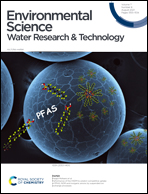Understanding the issues in monitoring the treatment effectiveness of constructed wetlands in urban areas – a case study in greater Melbourne, Australia†
Abstract
The popularity of constructed wetlands (CWs) in new residential development areas to remove nutrients and sediments from stormwater runoffs is increasing. However, with increased urbanisation and enhanced climate change, the need to continuously monitor the treatment effectiveness of these constructed wetlands (CWs) is important. Monitoring of these wetlands to assess their design capacities to reduce pollutants had been sporadically undertaken, and the information regarding the status of CWs is often not publicly accessible, hence, the fate of the CWs is a concern. To determine the barriers in monitoring effectively the treatment capacity of CWs, this paper presents the findings of a survey specifically targeting all the 32 local governments and water authorities who own and manage the CWs in metropolitan Melbourne. The survey highlighted that monitoring is affected by several factors including lack of funding, lack of expert knowledge, lack of guidance and maintenance, as well as technical feasibility. The opportunities and benefits in utilising citizen science programs and strengthening political influence were also noted. The results provide holistic insights into the barriers and opportunities in implementing routine monitoring of CWs.



 Please wait while we load your content...
Please wait while we load your content...